Implication of Mutual Assistance Evacuation Model to Reduce the Volcanic Risk for Vulnerable Society: Insight from Mount Merapi, Indonesia
Abstract
:1. Introduction
2. Related Studies
2.1. Mount Merapi Evacuation
2.2. Existing Evacuation Simulation Model
3. Materials and Methods
3.1. Study Area
3.2. Methodological Approaches
3.3. Walking Speed Measurement
3.4. Investigating Community Behavior
3.5. Agent-Based Evacuation Model
3.5.1. AnyLogic Simulation Principle
3.5.2. Evacuation Route Model
3.5.3. Logic Structure Model
3.5.4. Analysis Structure Model
4. Results
4.1. Simulation Performance
4.2. Effectiveness of the Mutual Assistance Model and the Traffic Phenomenon
4.2.1. Effect of Mutual Assistance on Pedestrian Evacuation
4.2.2. Effect of Traffic Phenomenon
4.3. Evacuation Time Analysis
4.4. Density Map Evaluation
4.5. Validation of the Result
5. Discussion
5.1. Mutual Assistance Model for Merapi Eruption: A Successful Evacuation?
5.2. Effective Mitigation for an Aging Population
5.3. Applicability for Various Volcanoes and Other Natural Disasters
5.4. Limitation and Future Research
6. Conclusions
Author Contributions
Funding
Institutional Review Board Statement
Informed Consent Statement
Data Availability Statement
Acknowledgments
Conflicts of Interest
Appendix A
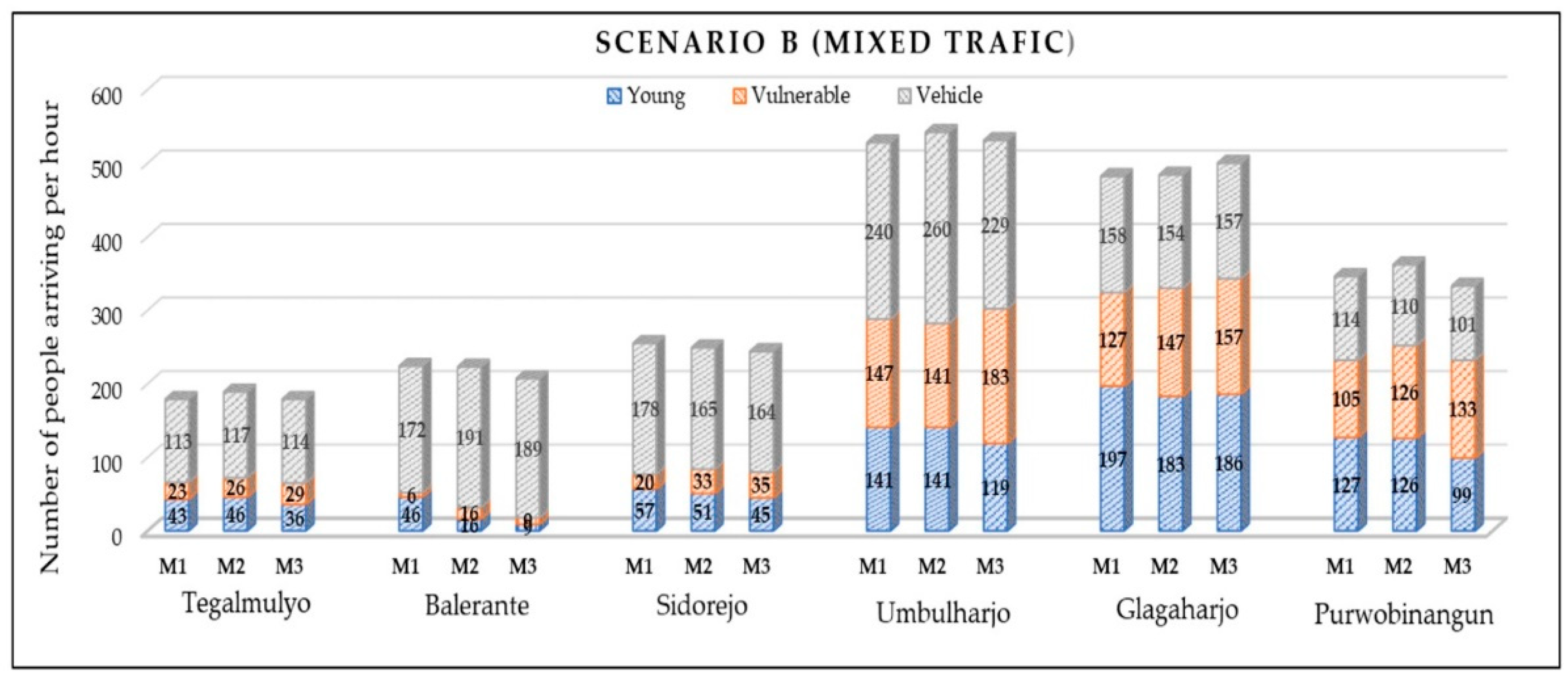
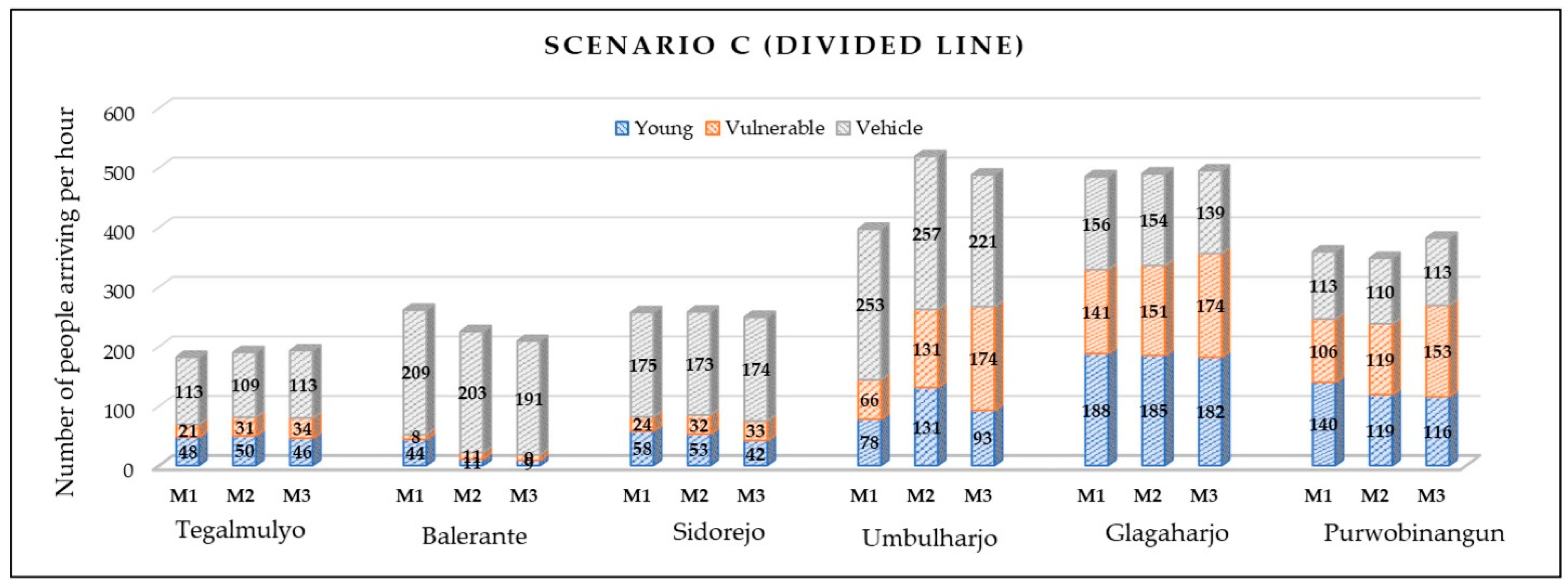
References
- Ostad-Ali-Askari, K. Management of Risks Substances and Sustainable Development. Appl. Water Sci. 2022, 12, 65. [Google Scholar] [CrossRef]
- National Disaster Management Agency. Rencana Nasional Penanggulangan Bencana 2015–2019; National Disaster Management Agency: Jakarta, Indonesia, 2014.
- Guha-Sapir, D.; Hoyois, P.; Below, R. Annual Disaster Statistical Review 2015: The Numbers and Trends Centre for Research on the Epidemiology of Disasters (CRED); CRED: Brussels, Belgium, 2016. [Google Scholar]
- Jousset, P.; Pallister, J.; Boichu, M.; Buongiorno, M.F.; Budisantoso, A.; Costa, F.; Andreastuti, S.; Prata, F.; Schneider, D.; Clarisse, L.; et al. The 2010 Explosive Eruption of Java’s Merapi Volcano-A “100-Year” Event. J. Volcanol. Geotherm. Res. 2012, 241–242, 121–135. [Google Scholar] [CrossRef] [Green Version]
- Mei, E.T.W.; Lavigne, F.; Picquout, A.; De Bélizal, E.; Brunstein, D.; Grancher, D.; Sartohadi, J.; Cholik, N.; Vidal, C. Lessons Learned from the 2010 Evacuations at Merapi Volcano. J. Volcanol. Geotherm. Res. 2013, 261, 348–365. [Google Scholar] [CrossRef]
- Klaten Regional Disaster Management Agency. Rencana Kontingensi Menghadapi Ancaman Erupsi Gunung Merapi Di Kabupaten Klaten; Klaten Regency: Central Java, Indonesia, 2018; Volume 1, ISBN 9781119130536.
- Liu, Q.; Lu, L.; Zhang, Y.; Hu, M. Modeling the Dynamics of Pedestrian Evacuation in a Complex Environment. Phys. A Stat. Mech. Its Appl. 2022, 585, 126426. [Google Scholar] [CrossRef]
- Gaudru, H. Overview of Potential Impact of Eruptions on Volcanic Islands: Global Approaches for Volcanic Risk Mitigation; European Volcanological Society: Geneva, Switzerland, 2004; pp. 1–5. [Google Scholar]
- Hakim, L.N. The Urgency of the Elderly Welfare Law Revision. Aspir. J. Masal. Sos. 2020, 11, 43–55. [Google Scholar] [CrossRef]
- Alalouf-Hall, D. “The Kamaishi Miracle”: Lessons Learned from the 2011 Tsunami in Japan. Altern. Humanit. Altern. 2019, 10, 148–161. [Google Scholar]
- Ma, Y.; Liu, X.; Huo, F. Analysis of Cooperation Behaviors and Crowd Dynamics during Pedestrian Evacuation with Group Existence. Sustainability 2022, 14, 5278. [Google Scholar] [CrossRef]
- Chasanah, F.; Sakakibara, H. Assessment of Social Vulnerability in the Evacuation Process from Mount Merapi: Focusing on People’s Behavior and Mutual Assistance. IDRiM J. 2021, 10, 46–65. [Google Scholar] [CrossRef]
- Hardiansyah, H.; Priyanto, S.; Muthohar, I.; Suparma, L.B. Effect of Merapi Disaster Evacuation on Road Network Performance in Yogyakarta Special Region. Int. J. Sci. Appl. Technol. 2018, 3, 1. [Google Scholar]
- Heppenstall, A.J.; Malleson, N.S.; Carver, S.J.; Quincey, D.J.; Manville, V.R. Modelling Individual Evacuation Decisions during Natural Disasters: A Case Study of Volcanic Crisis in Merapi, Indonesia. Geosciences 2018, 8, 196. [Google Scholar] [CrossRef] [Green Version]
- Jumadi, J.; Carver, S.J.; Quincey, D.J. An Agent-Based Evaluation of Varying Evacuation Scenarios in Merapi: Simultaneous and Staged. Geosciences 2019, 9, 317. [Google Scholar] [CrossRef] [Green Version]
- Maharani, Y.N.; Lee, S.; Ki, S.J. Social Vulnerability at a Local Level around the Merapi Volcano. Int. J. Disaster Risk Reduct. 2016, 20, 63–77. [Google Scholar] [CrossRef] [Green Version]
- Nugraha, A.L.; Firdaus, H.S.; Haeriah, S. Analysis of Risk Assessment of Mount Merapi Eruption in Settlement Area of Sleman Regency. IOP Conf. Ser. Earth Environ. Sci. 2019, 313, 012003. [Google Scholar] [CrossRef] [Green Version]
- Jumadi, J.; Malleson, N.; Carver, S.; Quincey, D. Estimating Spatio-Temporal Risks from Volcanic Eruptions Using an Agent-Based Model. Jasss 2020, 23, 2. [Google Scholar] [CrossRef] [Green Version]
- Burger, A.; Oz, T.; Kennedy, W.G.; Crooks, A.T. Computational Social Science of Disasters: Opportunities and Challenges. Future Internet 2019, 11, 103. [Google Scholar] [CrossRef] [Green Version]
- Hawe, G.I.; Coates, G.; Wilson, D.T.; Crouch, R.S. Agent-Based Simulation for Large-Scale Emergency Response: A Survey of Usage and Implementation. ACM Comput. Surv. 2012, 45, 1–51. [Google Scholar] [CrossRef] [Green Version]
- Avdeeva, M.; Uzun, O.; Borodkina, Y. Simulation of the Evacuation Process at Various Economic Facilities Using the Anylogic Software Product. E3S Web Conf. 2020, 175, 11031. [Google Scholar] [CrossRef]
- Zuo, J.; Shi, J.; Li, C.; Mu, T.; Zeng, Y.; Dong, J. Simulation and Optimization of Pedestrian Evacuation in High-Density Urban Areas for Effectiveness Improvement. Environ. Impact Assess. Rev. 2021, 87, 106521. [Google Scholar] [CrossRef]
- Liu, L.; Chen, H. Microscopic Simulation-Based Pedestrian Distribution Service Network in Urban Rail Station. Transp. Res. Interdiscip. Perspect. 2021, 9, 100313. [Google Scholar] [CrossRef]
- Sayudi, D.S.; Nurnaning, A.; Juliani, D.J.; Muzani, M. Peta Kawasan Rawan Bencana Gunung Api Merapi Jawa Tengah Dan Daerah Istimewa Yogyakarta 2010 (Merapi Hazard Map, Central Java and Yogyakarta Special Region Provinces). Available online: https://bpptkg.esdm.go.id/pub/page.php?idx=358 (accessed on 9 December 2019).
- Purnomo, S. Sunartono Peraturan Bupati Sleman Nomor 20 Tahun 2011 Tentang Kawasan Rawan Bencana Gunungapi Merapi; Sleman Regency Government: Yogyakarta, Indonesia, 2011; pp. 1–13.
- Abdurrachman, E. Geologic Des Produits de I’ Activite Historique et Contribution a I’Evaluation Des Risques Au Merapi (Java), Indonesia. Ph.D. Thesis, Universite d’Orleans, Orleans, France, 1998. [Google Scholar]
- Abdurachman, E.K.; Bourdier, J.L.; Voight, B. Nuées Ardentes of 22 November 1994 at Merapi Volcano, Java, Indonesia. J. Volcanol. Geotherm. Res. 2000, 100, 345–361. [Google Scholar] [CrossRef] [Green Version]
- Ministry of Energy and Mineral Resources; Geological Disaster Technology Research and Development Center. Laporan Aktivitas Gunung Merapi Tanggal 2–8 July 2021; Geological Disaster Technology Research and Development Center: Yogyakarta, Indoneisa, 2021.
- Ministry of Energy and Mineral Resources; Center for Volcanology and Geological Hazard Mitigation. Peningkatan Status Aktivitas Gunung Merapi Dari Level II Ke Level III; Geological Disaster Technology Research and Development Center: Yogyakarta, Indonesia, 2020.
- Transportation Research Board. Highway Capacity Manual; Transportation Research Board: Washington, DC, USA, 2000; ISBN1 0309066816. ISBN2 0309067464. [Google Scholar]
- Roess, R.P.; Prassas, E.S.; McShane, W. Traffic Engineering, 4th ed.; Peason: London, UK, 2011; ISBN 9780136135739. [Google Scholar]
- Wiley, J.S. Traffic Engineering Handbook, 7th ed.; Wiley: Hoboken, NJ, USA, 2016; ISBN 9780760768587. [Google Scholar]
- World Health Organization. Active Ageing: A Policy Framework; WHO: Madrid, Spain, 2002. [Google Scholar]
- Ministry of Transportation Republic of Indonesia. Peraturan Menteri Perhubungan Republik Indonesia Nomor PM 111 Tahun 2015, Tentang Tata Cara Penetapan Batas Kecepatan; Ministry of Transportation: Jakarta, Indonesia, 2015.
- Palinkas, L.A.; Horwitz, S.M.; Green, C.A.; Wisdom, J.P.; Duan, N.; Hoagwood, K. Purposeful Sampling for Qualitative Data Collection and Analysis in Mixed Method Implementation Research. HHS Public Access 2015, 42, 533–544. [Google Scholar] [CrossRef] [PubMed] [Green Version]
- Tongco, M.D.C. Purposive Sampling as a Tool for Informant Selection. Ethnobot. Res. Appl. 2007, 5, 147–158. [Google Scholar] [CrossRef] [Green Version]
- Regional Disaster Management Agency (BPBD Sleman). Rencana Kontijensi Erupsi Gunungapi Merapi; Sleman Regional Disaster Management Agency: Yogyakarta, Indonesia, 2019.
- Tegalmulyo Village Authority. Dokumen Rencana Kontijensi Bencana Erupsi Merapi Desa Tegalmulyo 2019; Tegalmulyo Village Authority: Klaten, Indonesia, 2019.
- Umbulharjo Village Authority. Dokumen Rencana Kontinjensi Bencana Erupsi Merapi Desa Umbulharjo 2019; Umbulharjo Village Authority: Yogyakarta, Indonesia, 2019.
- Glagaharjo Village Authority. Dokumen Rencana Kontijensi Bencana Erupsi Merapi Desa Glagaharjo 2019; Glagaharjo Village Authority: Yogyakarta, Indonesia, 2019.
- Purwobinangun Village Authority. Dokumen Rencana Kontijensi Bencana Erupsi Merapi Desa Purwobinangun 2019; Purwobinangun Village Authority: Yogyakarta, Indonesia, 2019.
- Tegalmulyo Village Authority. Hasil Assessment Desa Tegalmulyo 2020; Tegalmulyo Village Authority: Klaten, Indonesia, 2020.
- Balerante Village Authority. Data Analisis PRB Desa Balerante 2020; Balerante Village Authority: Klaten, Indonesia, 2020.
- Sidorejo Village Authority. Data KK dan Aset Keluarga Desa Sidorejo 2019; Sidorejo Village Authority: Klaten, Indonesia, 2019.
- Taylor, S.J. Agent-Based Modeling and Simulation; Palgrave Macmillan: Jakarta, Indonesia, 2014. [Google Scholar]
- Gilbert, N. Agent-Based Models; SAGE Publications: London, UK, 2008; ISBN 978-1-4129-4964-4. [Google Scholar]
- Karaaslan, E.; Noori, M.; Lee, J.Y.; Wang, L.; Tatari, O.; Abdel-Aty, M. Modeling the Effect of Electric Vehicle Adoption on Pedestrian Traffic Safety: An Agent-Based Approach. Transp. Res. Part C Emerg. Technol. 2018, 93, 198–210. [Google Scholar] [CrossRef]
- Troitzsch, K.G. Validating Simulation Models. In Proceedings of the Proceeding’s 18th European Simulation Multiconference Graham Horton, Erlangen, Germany, 13 June 2004. [Google Scholar]
- Republic of Indonesia. Geospatial Untuk Negeri. Available online: https://tanahair.indonesia.go.id/portal-web (accessed on 12 October 2021).
- Ministry of Public Works and Housing; Direktorat Jenderal Bina Marga (DJBM). Pedoman Desain Geometrik Jalan 2020; Kementrian Pekerjaan Umum dan Perumahan Rakyat-Direktorat Jenderal Bina Marga: Jakarta, Indonesia, 2020.
- Transportation Research Board. HCM 2010-Highway Capacity Manual, Volume 1: Concepts; Transportation Research Board: Washington, DC, USA, 2010; ISBN 9780309160773. [Google Scholar]
- Rahman, M.M.; Deb, S.; Strawderman, L.; Smith, B.; Burch, R. Evaluation of Transportation Alternatives for Aging Population in the Era of Self-Driving Vehicles. IATSS Res. 2020, 44, 30–35. [Google Scholar] [CrossRef]
- Benson, W.F. Disaster Planning Tips for Older Adults and Their Families. 2013. Available online: https://www.cdc.gov/aging/pdf/disaster_planning_tips.pdf (accessed on 22 May 2022).
- Lechner, H.N.; Rouleau, M.D. Should We Stay or Should We Go Now? Factors Affecting Evacuation Decisions at Pacaya Volcano, Guatemala. Int. J. Disaster Risk Reduct. 2019, 40, 101160. [Google Scholar] [CrossRef]
- Niroa, J.J.; Nakamura, N. Volcanic Disaster Risk Reduction in Indigenous Communities on Tanna Island, Vanuatu. Int. J. Disaster Risk Reduct. 2022, 74, 102937. [Google Scholar] [CrossRef]
- Ohtsu, N.; Hokugo, A.; Cruz, A.M.; Sato, Y.; Araki, Y.; Park, H. Evacuation of Vulnerable People during a Natech: A Case Study of a Flood and Factory Explosion in Japan. Int. J. Disaster Resil. Built Environ. 2021, 1759–5908. [Google Scholar] [CrossRef]
- Bian, R.; Wilmot, C.G. An Analysis on Transit Pick-up Points for Vulnerable People during Hurricane Evacuation: A Case Study of New Orleans. Int. J. Disaster Risk Reduct. 2018, 31, 1143–1151. [Google Scholar] [CrossRef]
- Subhajyoti, S.; Hirokazu, T. Where Do Individuals Seek Opinions for Evacuation? A Case Study from Landslide-Prone Slum Communities in Mumbai. J. Nat. Disaster Sci. 2015, 36, 13–24. [Google Scholar] [CrossRef] [Green Version]
- Center for Disease Control and Prevention (CDC). Planning for an Emergency: Strategies for Identifying and Engaging At-Risk Groups; Center for Disease Control and Prevention (CDC): Chamblee, GA, USA, 2015; ISBN 7704883410.
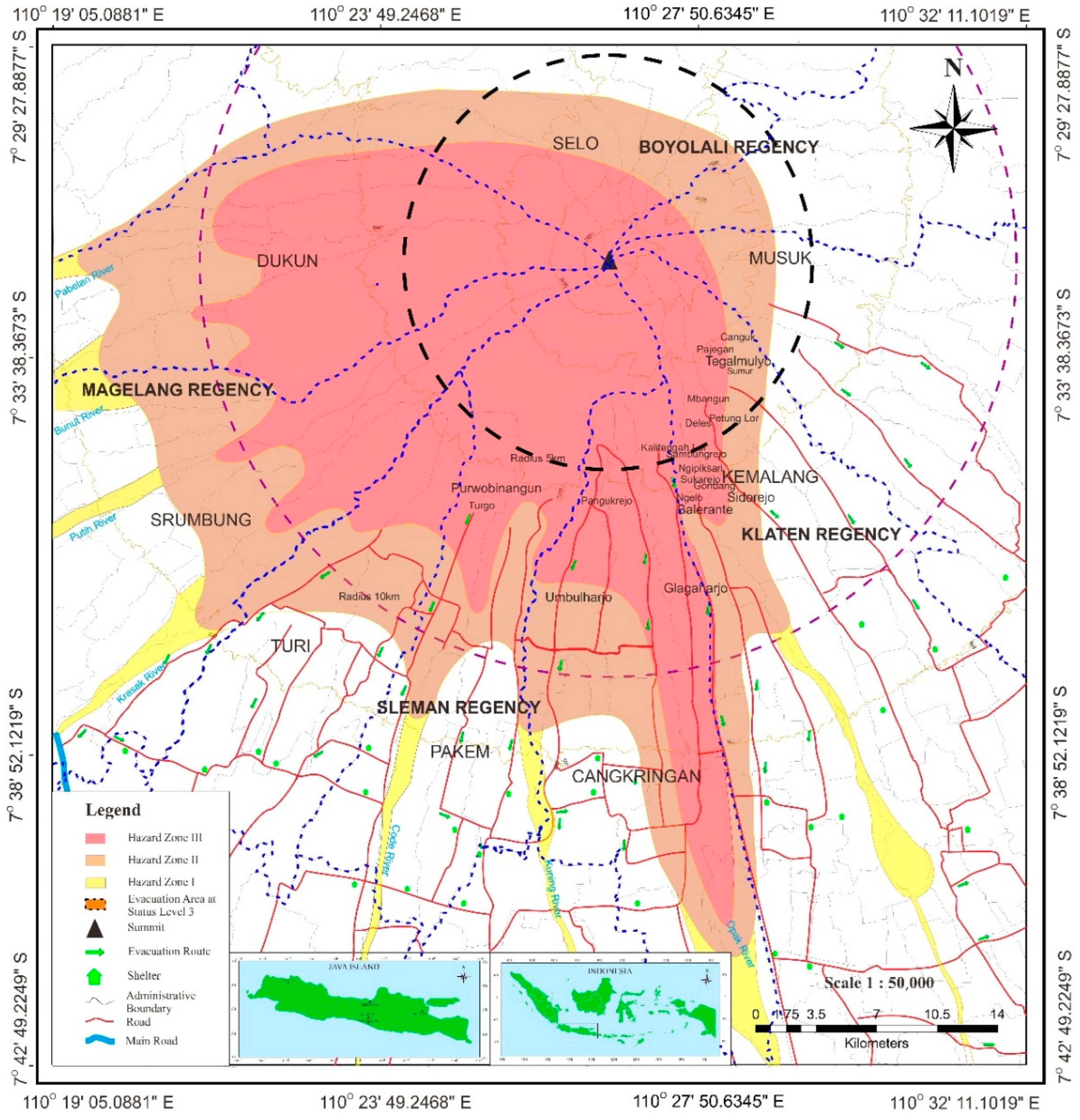
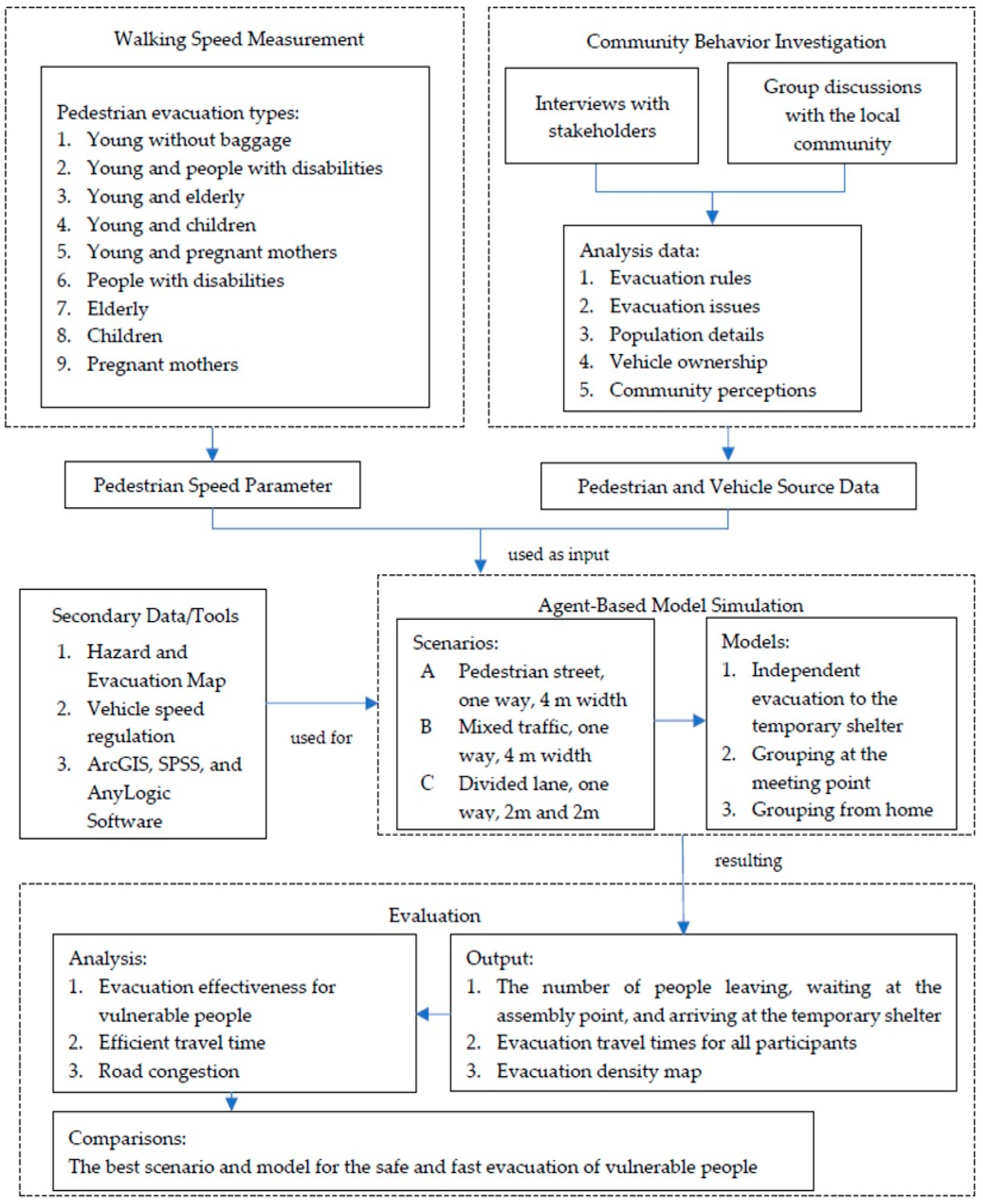
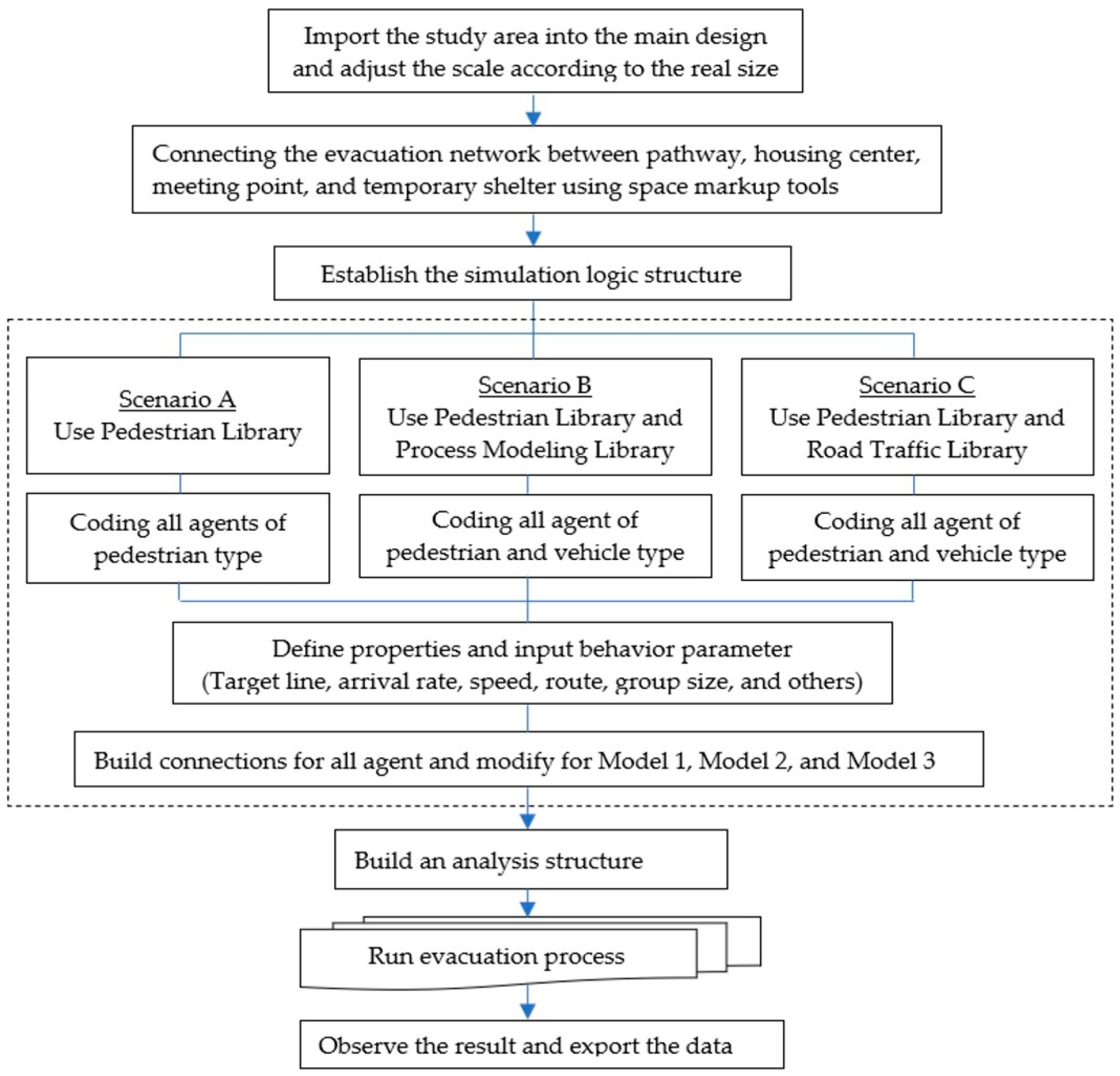


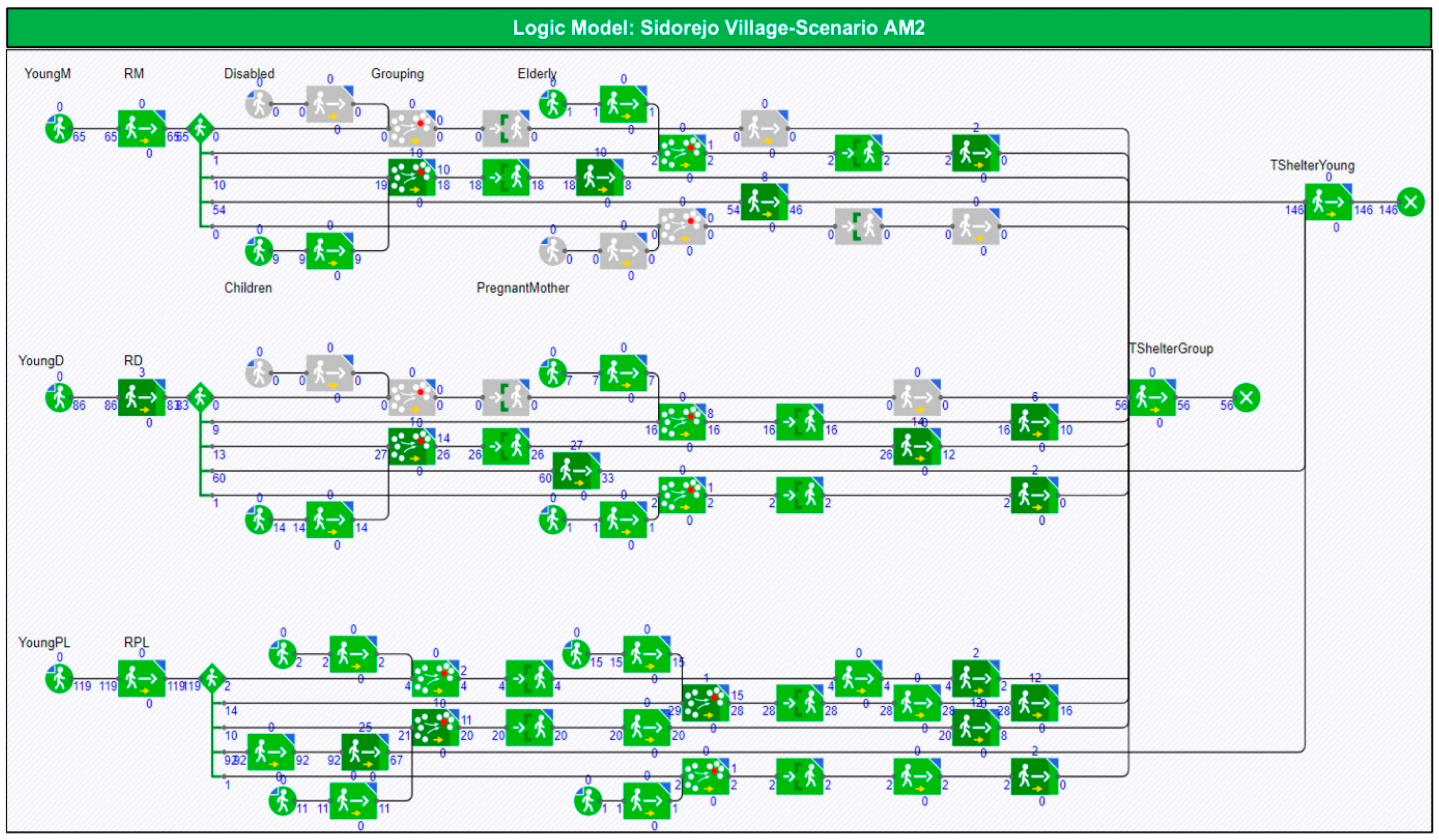

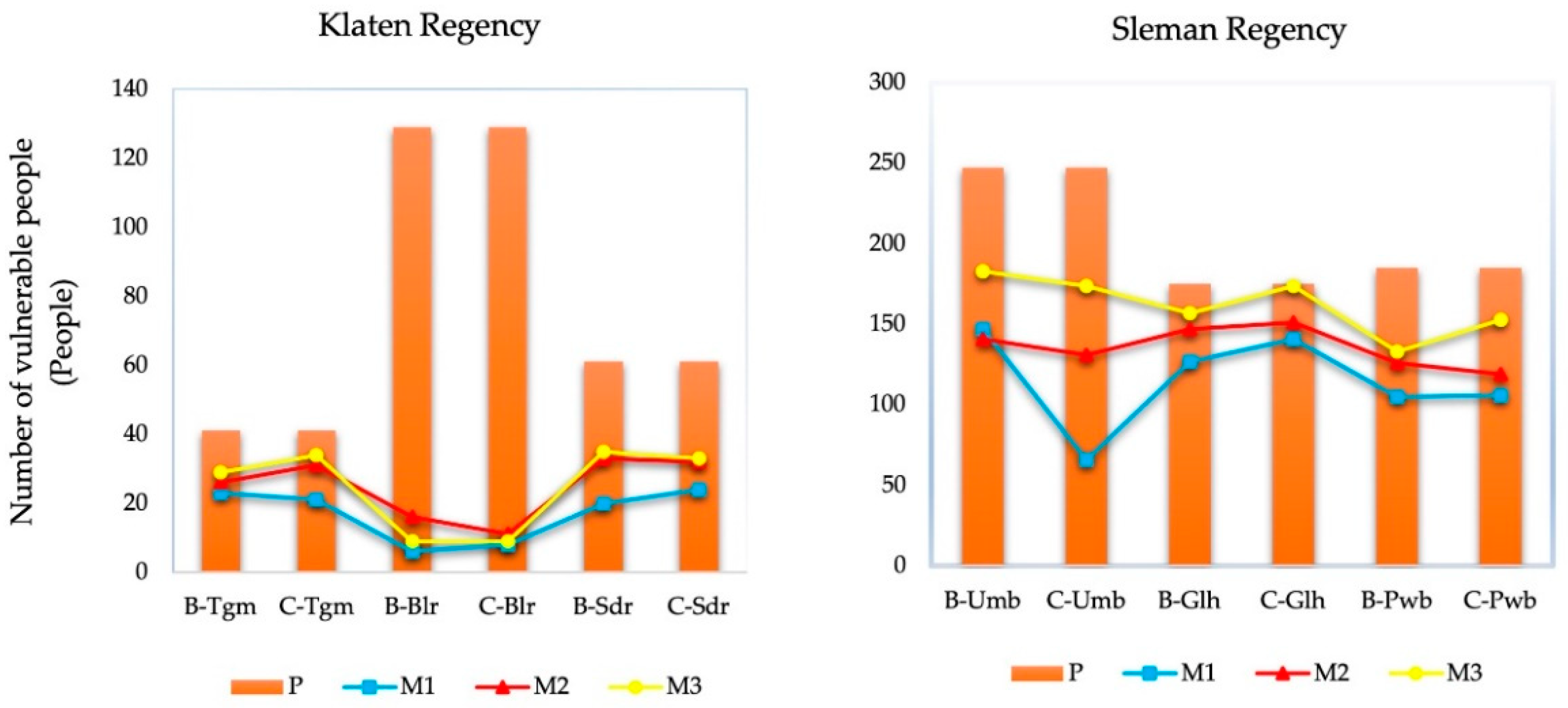

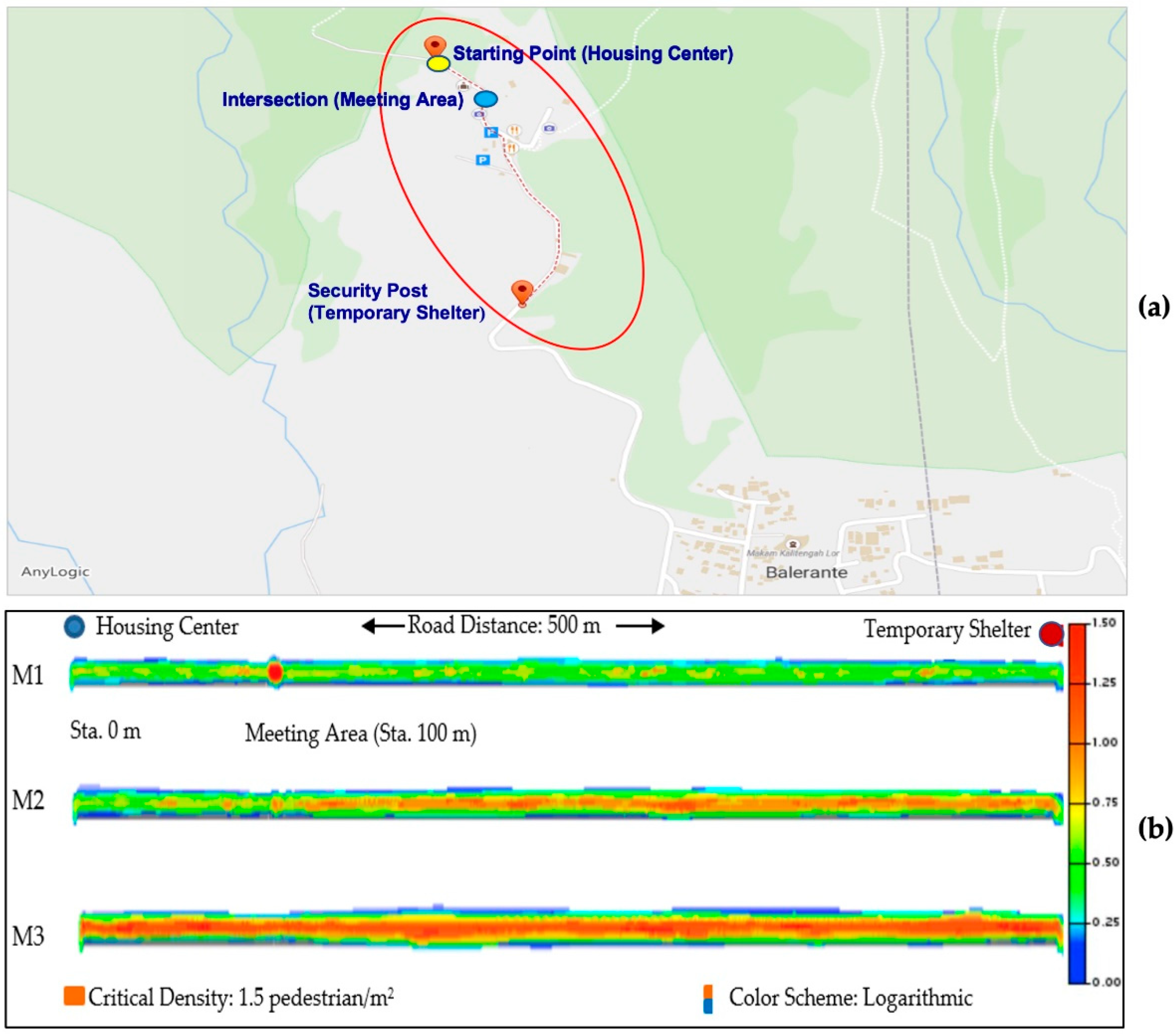
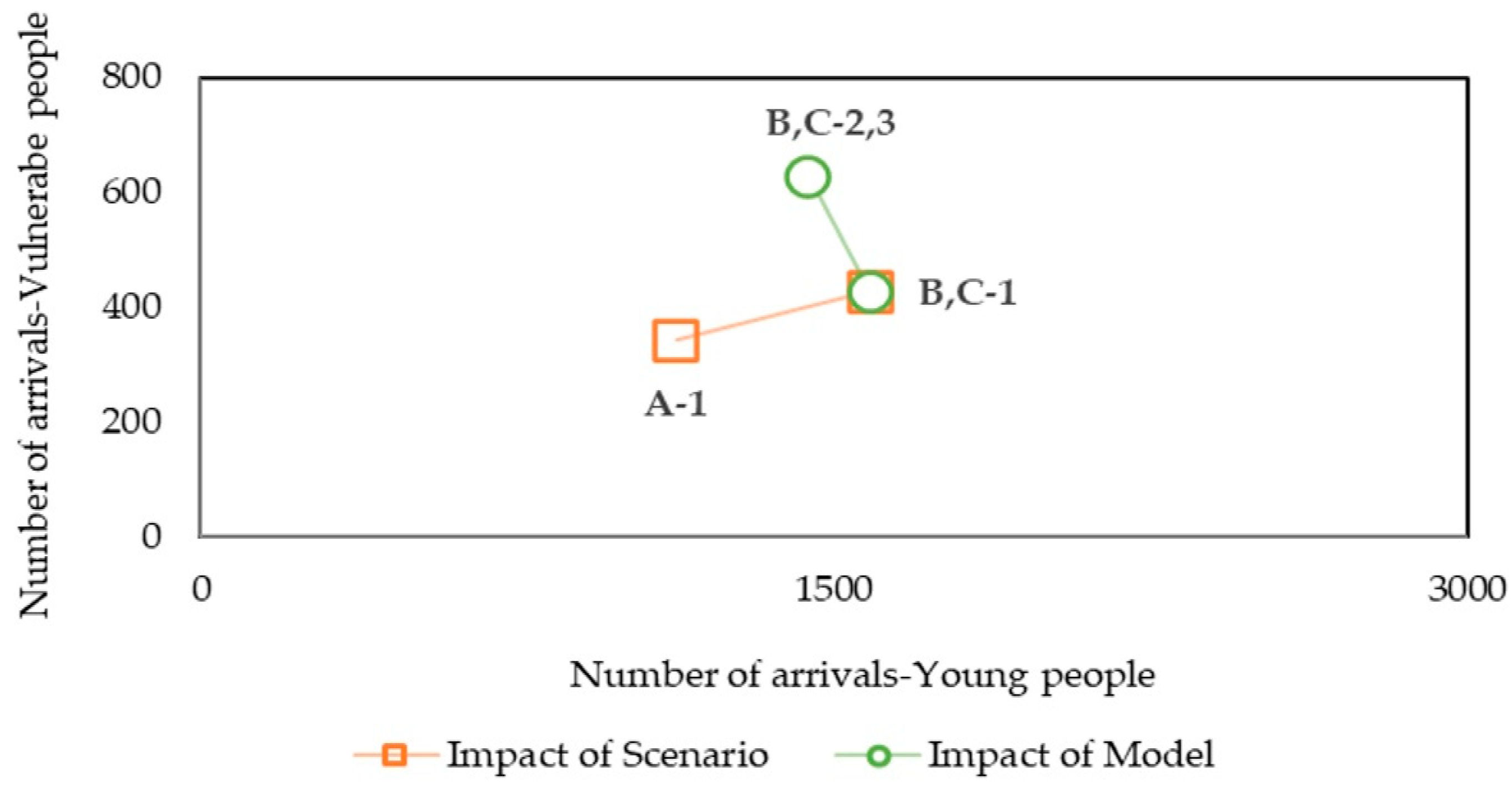
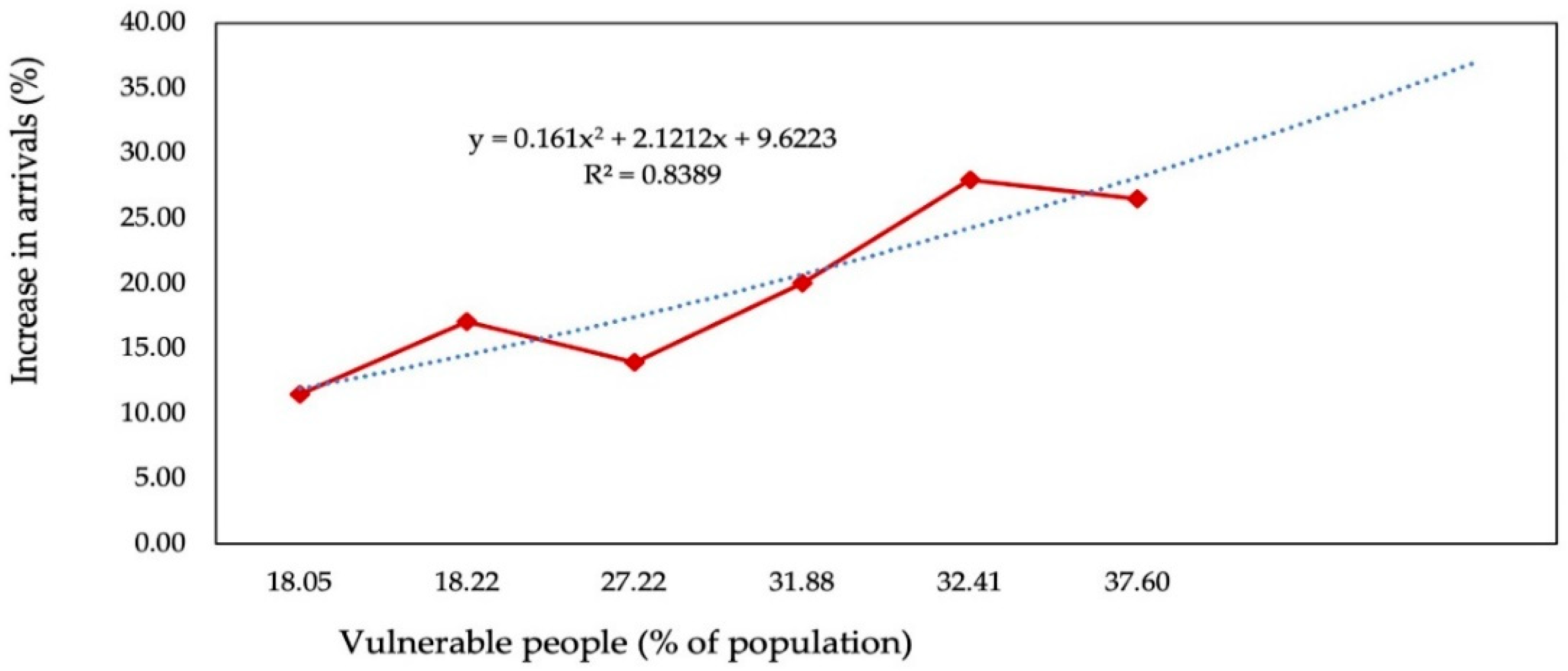
| Villages | Hamlets | Width (m) | Distance (km) | Young People with Vehicle | Young Pedestrians | Vulnerable Pedestrians | Total Population |
|---|---|---|---|---|---|---|---|
| Klaten Regency | |||||||
| Tegalmulyo | Canguk | 4 | 2 | 44 | 22 | 18 | 84 |
| Pajegan | 4 | 2 | 20 | 14 | 15 | 49 | |
| Sumur | 4 | 1.5 | 55 | 29 | 8 | 92 | |
| Total | 119 | 65 | 41 | 225 | |||
| Balerante | Sambungrejo | 4 | 4.7 | 42 | 38 | 38 | 118 |
| Ngipiksari | 4 | 4 | 45 | 34 | 34 | 113 | |
| Sukarejo | 4 | 3.7 | 23 | 22 | 22 | 67 | |
| Gondang | 4 | 3.4 | 90 | 30 | 30 | 150 | |
| Ngelo | 4 | 3.6 | 16 | 5 | 5 | 26 | |
| Total | 216 | 129 | 129 | 474 | |||
| Siderejo | Mbangan | 4 | 2.5 | 44 | 21 | 10 | 75 |
| Deles | 4 | 2.4 | 63 | 30 | 22 | 115 | |
| Petung Lor | 4 | 2.7 | 73 | 46 | 29 | 148 | |
| Total | 180 | 97 | 61 | 338 | |||
| Sleman Regency | |||||||
| Umbulharjo | Pangukrejo | 4 | 1.5 | 268 | 247 | 247 | 762 |
| Glagaharjo | Kalitengah Lor | 4 | 0.5 | 158 | 216 | 175 | 549 |
| Purwobinangun | Turgo | 4 | 1.2 | 122 | 185 | 185 | 492 |
| Village | Hamlets | Meeting Point | Temporary Shelter | Shelter/Sister Village |
|---|---|---|---|---|
| Klaten Regency | ||||
| Tegalmulyo | Canguk | Intersection | Tegalmulyo Village Office | Demak Ijo Village |
| Pajegan | Intersection | Tegalmulyo Village Office | Demak Ijo Village | |
| Sumur | Intersection | Tegalmulyo Village Office | Demak Ijo Village | |
| Balerante | Sambungrejo | Intersection | Balerante Village Office | Kebondalem Lor Village |
| Ngipiksari | Intersection | Balerante Village Office | Kebondalem Lor Village | |
| Sukarejo | Intersection | Balerante Village Office | Kebondalem Lor Village | |
| Gondang | Intersection | Balerante Village Office | Kebondalem Lor Village | |
| Ngelo | Intersection | Balerante Village Office | Kebondalem Lor Village | |
| Siderejo | Mbangan | Intersection | Sidorejo Village Office | Menden Village |
| Deles | Intersection | Sidorejo Village Office | Menden Village | |
| Petung Lor | Intersection | Sidorejo Village Office | Menden Village | |
| Sleman Regency | ||||
| Umbulharjo | Pangukrejo | Intersection | Merapi Garden Cangkringan | Plosokerep Barrack, Umbulharjo |
| Glagaharjo | Kalitengah Lor | Intersection | Security Post, Kalitengah Lor | Gayam Barrack, Argomulyo |
| Purwobinangun | Turgo | Intersection | Tritis Field, Turgo | Purwobinangun Barrack, Watuadeg |
| Area | Model | Population Numbers Arriving at Temporary Shelter (People/h) | Percentage Increase in Arrivals of Vulnerable People (%) | ||
|---|---|---|---|---|---|
| Young | Vulnerable | Total | |||
| Klaten Regency | |||||
| Tegalmulyo (Canguk, Pajekan, Sumur) | M1 | 132 | 22 | 154 | |
| M2 | 154 | 24 | 178 | 4.88 | |
| M3 | 144 | 29 | 173 | 17.07 | |
| Balerante (Sambungrejo, Ngipiksari, Ngelo, Gondang, Sukarejo) | M1 | 98 | 8 | 106 | |
| M2 | 84 | 26 | 110 | 13.95 | |
| M3 | 80 | 10 | 90 | 1.55 | |
| Sidorejo (Mbangan, Ndeles, Petung Lor) | M1 | 159 | 26 | 185 | |
| M2 | 174 | 28 | 202 | 3.28 | |
| M3 | 162 | 33 | 195 | 11.48 | |
| Sleman Regency | |||||
| Umbulharjo (Pangukrejo) | M1 | 178 | 53 | 231 | |
| M2 | 299 | 119 | 418 | 26.72 | |
| M3 | 266 | 122 | 388 | 27.94 | |
| Glagaharjo (Kalitengah Lor) | M1 | 332 | 133 | 465 | |
| M2 | 343 | 160 | 503 | 15.43 | |
| M3 | 314 | 168 | 482 | 20.00 | |
| Purwobinangun (Turgo) | M1 | 229 | 100 | 329 | |
| M2 | 214 | 120 | 334 | 10.81 | |
| M3 | 195 | 149 | 344 | 26.49 | |
| Scenarios | Sum of Squares | df | Mean Square | F | Sig. | |
|---|---|---|---|---|---|---|
| AM1 | Between Groups | 494.083 | 1 | 494.083 | 0.015 | 0.904 |
| Within Groups | 323,302.833 | 10 | 32,330.283 | |||
| Total | 323,796.917 | 11 | ||||
| AM2 | Between Groups | 234.083 | 1 | 234.083 | 0.007 | 0.934 |
| Within Groups | 328,746.833 | 10 | 32,874.683 | |||
| Total | 328,980.917 | 11 | ||||
| AM3 | Between Groups | 10.083 | 1 | 10.083 | 0.000 | 0.987 |
| Within Groups | 343,120.167 | 10 | 34,312.017 | |||
| Total | 343,130.250 | 11 | ||||
| BM1 | Between Groups | 1121.333 | 1 | 1121.333 | 0.034 | 0.857 |
| Within Groups | 325,729.333 | 10 | 32,572.933 | |||
| Total | 326,850.667 | 11 | ||||
| BM2 | Between Groups | 720.750 | 1 | 720.750 | 0.021 | 0.887 |
| Within Groups | 341,238.167 | 10 | 34,123.817 | |||
| Total | 341,958.917 | 11 | ||||
| BM3 | Between Groups | 456.333 | 1 | 456.333 | 0.012 | 0.915 |
| Within Groups | 378,832.667 | 10 | 37,883.267 | |||
| Total | 379,289.000 | 11 | ||||
| CM1 | Between Groups | 588.000 | 1 | 588.000 | 0.017 | 0.898 |
| Within Groups | 338,922.667 | 10 | 33,892.267 | |||
| Total | 339,510.667 | 11 | ||||
| CM2 | Between Groups | 330.750 | 1 | 330.750 | 0.010 | 0.923 |
| Within Groups | 333,582.167 | 10 | 33,358.217 | |||
| Total | 333,912.917 | 11 | ||||
| CM3 | Between Groups | 126.750 | 1 | 126.750 | 0.004 | 0.953 |
| Within Groups | 339,792.167 | 10 | 33,979.217 | |||
| Total | 339,918.917 | 11 | ||||
Publisher’s Note: MDPI stays neutral with regard to jurisdictional claims in published maps and institutional affiliations. |
© 2022 by the authors. Licensee MDPI, Basel, Switzerland. This article is an open access article distributed under the terms and conditions of the Creative Commons Attribution (CC BY) license (https://creativecommons.org/licenses/by/4.0/).
Share and Cite
Chasanah, F.; Sakakibara, H. Implication of Mutual Assistance Evacuation Model to Reduce the Volcanic Risk for Vulnerable Society: Insight from Mount Merapi, Indonesia. Sustainability 2022, 14, 8110. https://doi.org/10.3390/su14138110
Chasanah F, Sakakibara H. Implication of Mutual Assistance Evacuation Model to Reduce the Volcanic Risk for Vulnerable Society: Insight from Mount Merapi, Indonesia. Sustainability. 2022; 14(13):8110. https://doi.org/10.3390/su14138110
Chicago/Turabian StyleChasanah, Faizul, and Hiroyuki Sakakibara. 2022. "Implication of Mutual Assistance Evacuation Model to Reduce the Volcanic Risk for Vulnerable Society: Insight from Mount Merapi, Indonesia" Sustainability 14, no. 13: 8110. https://doi.org/10.3390/su14138110







